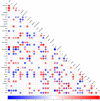Lipidomic analyses of five Carya illinoinensis cultivars
- PMID: 37823132
- PMCID: PMC10563669
- DOI: 10.1002/fsn3.3572
Lipidomic analyses of five Carya illinoinensis cultivars
Abstract
Carya illinoinensis (Wangenh.) K. Koch, nuts are a renowned health food. However, there are many cultivars of this nut tree, and their mature kernel lipid composition has not been thoroughly studied. Therefore, we used liquid chromatography-mass spectrometry (LC-MS) to analyze the lipid composition of mature nuts of five C. illinoinensis cultivars. In the mature kernels of all cultivars, there were 58 lipid types which were mainly composed of glycerolipids (c. 65%) and phospholipids (>30%). Triacylglycerol (TG) accounted for the largest proportion of mature nuts of all cultivars, exceeding 50%; and diacylglycerol (DG), ceramide (Cer), phosphatidylcholine (PC), and phosphatidylethanolamine (PE) were also relatively high. Additionally, nuts contain fatty acids, mainly oleic, linoleic, and linolenic acids. Our research provides a new perspective for the processing and utilization of plant and edible oils, and for the use of C. illinoinensis kernels in the development of medicine and food science.
Keywords: Carya illinoinensis; cultivars; kernel; lipidomics; nutrients.
© 2023 The Authors. Food Science & Nutrition published by Wiley Periodicals LLC.
Conflict of interest statement
The authors declare that they have no known competing financial interests or personal relationships that could have appeared to influence the work reported in this paper.
Figures







References
-
- Alasalvar, C. , & Bolling, B. W. (2015). Review of nut phytochemicals, fat‐soluble bioactives, antioxidant components and health effects. The British Journal of Nutrition, 113(Suppl 2), S68–S78. - PubMed
-
- Concilco‐Alberto, E. , Valenzuela‐Núñez, L. M. , González‐Torres, A. , La Peña, C. G. , Briceño‐Contreras, E. A. , Rivera, J. R. E. , Reyes‐Carrillo, J. L. , & García‐Carrillo, M. (2022). Total soluble sugars in root and stem of Wichita and Western Carya Illinoinensis cultivars in northern Mexico. Rural Sustainability Research, 47(342), 8–15.
-
- Dalli, J. , Colas, R. A. , Walker, M. E. , & Serhan, C. N. (2018). Lipid mediator metabolomics via LC‐MS_MS profiling and analysis. Methods in Molecular Biology, 1730, 59–72. - PubMed
LinkOut - more resources
Full Text Sources
Miscellaneous

